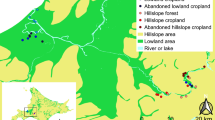Abstract
The results of a biodiversity monitoring program conducted in the Ogawa Forest Reserve and its vicinity, situated in a cool temperate region of Japan, identified three different patterns for species richness. Forests of the region are characterized by a mosaic of secondary deciduous stands of various ages scattered among plantations of conifers. The three different types of change in species richness observed in response to the stand age are as follows:
-
Type I (butterflies, tube-renting bees and wasps, hoverflies, fruit flies, and longicorn beetles), the species diversity was highest in open areas, just after clear-cutting, decreasing with the stand age;
-
Type II (mushrooms and mites associated with them), older stands showed greater diversity than younger stands; and,
-
Type III (moths, oribatid mites, collembolas, carabid beetles, and ants), the number of species did not change greatly with the stand age, though ordination analysis revealed that there was variation in species compositions. These results indicate that combinations of stands of different ages, or heterogeneously arranged stands, can contribute to the maintenance of insect biodiversity at the landscape level.
Similar content being viewed by others
References
Fye, R. E.: 1965, ‘The biology of the Vespidae, Pompilidae, and Sphecidae (Hymenoptera) from Trap Nests in Northwestern Ontario’, Canadian Entomologist 97, 716–744.
Hasegawa, M., Fukuyama, K., Makino, S., Okochi, I., Goto, H., Mizoguchi, T., Sakata, T. and Tanaka, H.: 2004,‘Collembolan and oribatid mites community dynamics with the secondary succession of deciduous forests in Japan’, Abstracts of International Congress of Entomology, 2004 (distributed with CD-ROM).
Inoue, T.: 2003, ‘Chronosequential change in a butterfly community after clear-cutting of deciduous forests in a cool temperate region of central Japan’, Entomological Science 6, 151–163.
Maetô, K. and Makihara, H.: 1999, ‘Changes in insect assemblages with secondary succession of temperate deciduous forests after clear-cutting’, Japanese Journal of Entomology (N.S.) 2, 11–26 (in Japanese).
Maetô, K., Sato, S. and Miyata, H.: 2002, ‘Species diversity of longicorn beetles in humid temperate forests: the impact of forest management practices on old-growth forest species in southwestern Japan’, Biodiversity and Conservation 11, 1919–2002.
Maetô, K. and Sato, S.: 2003, ‘Impacts of forestry on ant species richness and composition in warm-temperate forests of Japan’, Forest Ecology and Management 187, 213–223.
Matsuka, H.: 1994, Butterflies: A Color Handbook, PHP Press, Tokyo, 215 pp.
Miyata, A.: 1983, A Handbook of the Natural History of Moths of Japan,. Syowado Press (in Japanese). 1451 pp.
Nakashizuka, T. and Matsumoto, Y.: 2002, Diversity and Interaction in a Temperate Forest Community, Springer Verlag, Tokyo, 319 pp.
Niemelä, J.: 2001, ‘Carabid beetles (Coleoptera: Carabidae) and habitat fragmentation: A review’, European Journal of Entomology 98, 127–132.
Okochi, I.: 2002, ‘A new portable light trap for moth collection’, Bulletin of Forestry and Forest Products Research Institute 1, 231–234.
Spies, T. A. and Franklin, J. F.: 1988, ‘Old-growth and forest dynamics in the Douglas-fir region of western Oregon and Washington’, Nat. Sci. 72, 51–53.
Sueyoshi, M., Maetô, K., Makihara, H., Makino, S. and Iwai, T.: 2003, ‘Changes in dipteran assemblages with secondary succession of temperate deciduous forests following clear-cutting’, Bulletin of Forestry and Forest Products Research Institute 2, 171–192 (in Japanese).
Toda, M. J.: 1987, ‘Vertical microdistribution of Drosophilidae (Diptera) within various forests in Hokkaido III. The Tomakomai Experimental Forest, Hokkaido University’, Research Bulletin of the College Experimental Forests, Hokkaido University 44, 611–632.
Totok, M. U., Makino, S. and Goto, H.: 2002, ‘Species compositions and seasonal changes in the number of social wasps collected with Malaise traps in natural deciduous forests in and near the Ogawa Research Forest, northern Kanto, Japan (Hymenoptera, Vespidae)’, Bulletin of Forestry and Forest Products Research Institute 1, 135–139.
Trofymow, J. A., Addison, J., Blackwell, B. A., He, F., Preston, C. A. and Marshall, V. G.: 2003, ‘Attributes and indicators of old-growth and successional Douglas-fir forests on Vancouver Island’, Environ. Rev. 11, S1–S18.
Tscharntke, T., Gathmann, A. and Steffan-Dewenter, I.: 1998. ‘Bioindication using trap-nesting bees and wasps and their natural enemies: community structure and interactions’, Journal of Applied Ecology 35, 708–719.
Warren, M. S. and Key, R. S.: 1991, ‘Woodlands: Past, present and potential for insects’. In: Collins, N. M. and Thomas, J. A. (eds.), The conservation of insects and their habitats: 155–211, Academic Press, London, 450 pp.
Yoshida, K.: 1983, ‘Heterogeneous environmental structure in a moth community of Tomakomai Experimental Forest, Hokkaido University’, Japanese Journal of Ecology 33, 445–451.
Author information
Authors and Affiliations
Corresponding author
Rights and permissions
About this article
Cite this article
Makino, S., Goto, H., Inoue, T. et al. The Monitoring of Insects to Maintain Biodiversity in Ogawa Fores Reserve. Environ Monit Assess 120, 477–485 (2006). https://doi.org/10.1007/s10661-005-9074-8
Received:
Accepted:
Published:
Issue Date:
DOI: https://doi.org/10.1007/s10661-005-9074-8




